
The Virgin River, Zion National Park / Rebecca Latson
There’s always something to learn when visiting any of the 423 units within the National Park System. How much do you know? Test your knowledge with this quiz and trivia piece and maybe learn a thing or two, as well.
1. The Virgin River in Zion National Park carries out _____ of sediment every year.
a) 1 million tons
b) 2 million tons
c) 3 million tons
d) 4 million tons

Eastern lubber grasshopper, Everglades National Park / NPS - A. Tintori
2. The image above is of the Eastern lubber, a colorful, large grasshopper you might see during a walk in Everglades National Park. According to this park, “Eastern lubbers contain toxic chemicals in their bodies that are lethal for certain bird species and can cause small mammals like opossums to feel sick for quite some time … When an animal [or insect] uses a visual cue to warn predators that it is toxic or dangerous, that is called _____.”
a) Toxic calamitism
b) Toxic secretionism
c) Aposematism
d) Toxic pigment secretionism
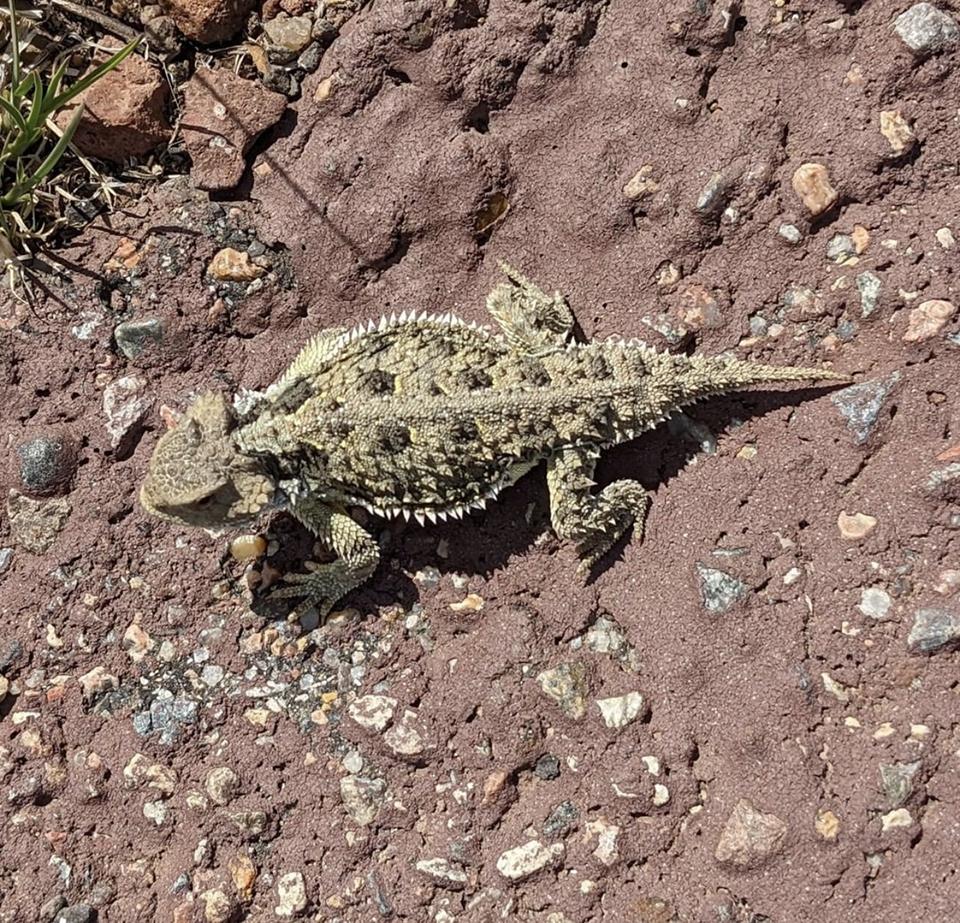
Horned-lizard aka "horny toad," Capulin Volcano National Monument / NPS - Ranger Melissa
3. While hiking within Capulin Volcano National Monument, you might come across the short-horned lizard, aka “horny toad.” True or false, when threatened, horny toads will sometimes squirt urine from their eyes.
a) True
b) False
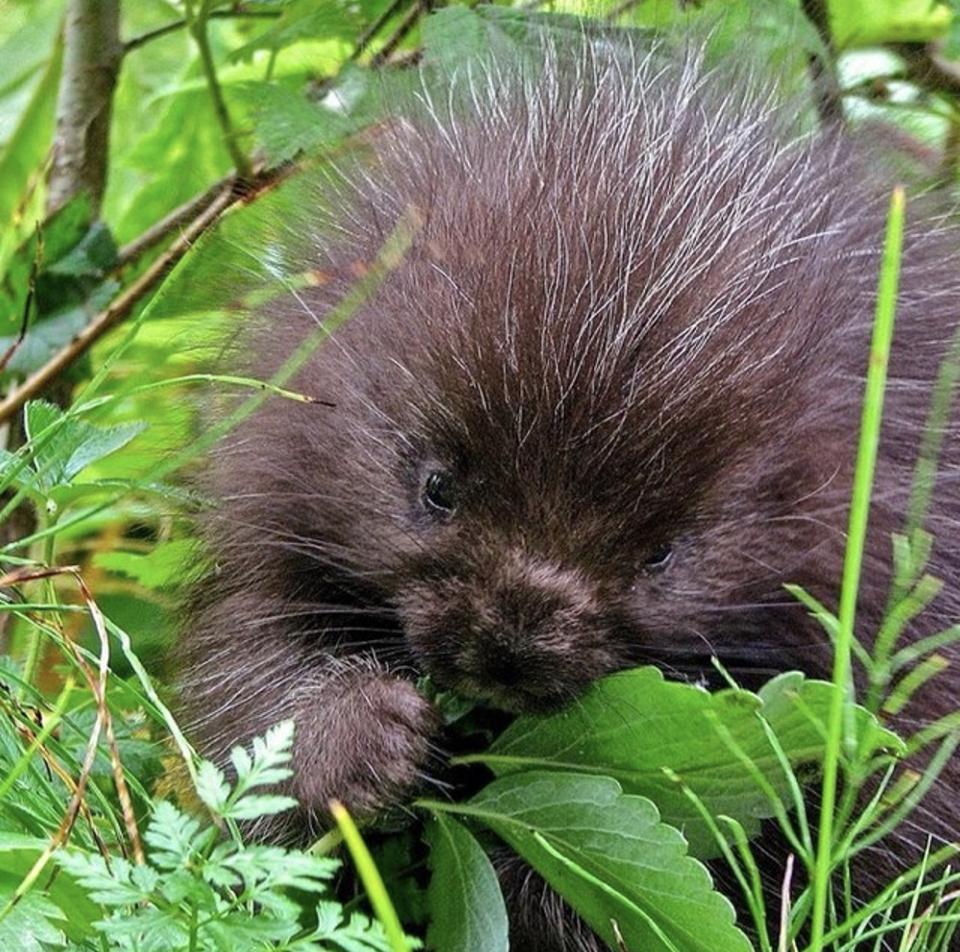
Awwww, a sweet little baby porcupine, Glacier Bay National Park and Preserve / National Park Service
4. Porcupines are large, prickly rodents that can be found in many National Park System units, including Glacier Bay National Park and Preserve in Alaska. True or False: the name for a baby porcupine is a porcupittle.
a) True
b) False
5. Let’s stick with porcupines just a little longer. True or False: according to an Instagram post by the National Park Service, a porcupine (aka “needle beaver”) can throw its quills a distance of 3 feet.
a) True
b) False

Ice formations along Lake Michigan, Indiana Dunes National Park / NPS - Rafi Wilkinson
6. During the winter, as you explore along the frozen southern shore of Lake Michigan at Indiana Dunes National Park, you might come across these interesting ice formations known as ____.
a) Ice balls
b) Ice globs
c) Ice mounds
d) Ice rocks

A colorful bromeliad, Everglades National Park / Kim O'Connell
a) True
b) False
8. True or False: Landscape Arch is the largest free-standing arch in Arches National Park.
a) True
b) False

Looking southwest from Dry Falls along the Ice Age Floods National Geologic Trail / Rebecca Latson
9. The Ice Age Floods National Geologic Trail will take the intrepid road tripper along a route from Montana to Idaho to Washington state to Oregon. Along the way, in Washington state, you’ll travel over, along, and through a maze of basalt ravines hundreds of feet deep, with little to no vegetation. Floodwaters of unimaginable depth and power scoured this landscape to create what is known as the ____.
a) Grand Coulee
b) Cordilleran Floodplain
c) Grand Prairie
d) Channeled Scabland
10. Montezuma Well at Montezuma Castle National Monument, is home to ____ endemic species. Endemic means they don’t live anywhere else in the world except there.
a) Five
b) Six
c) Seven
d) Eight
Trivia
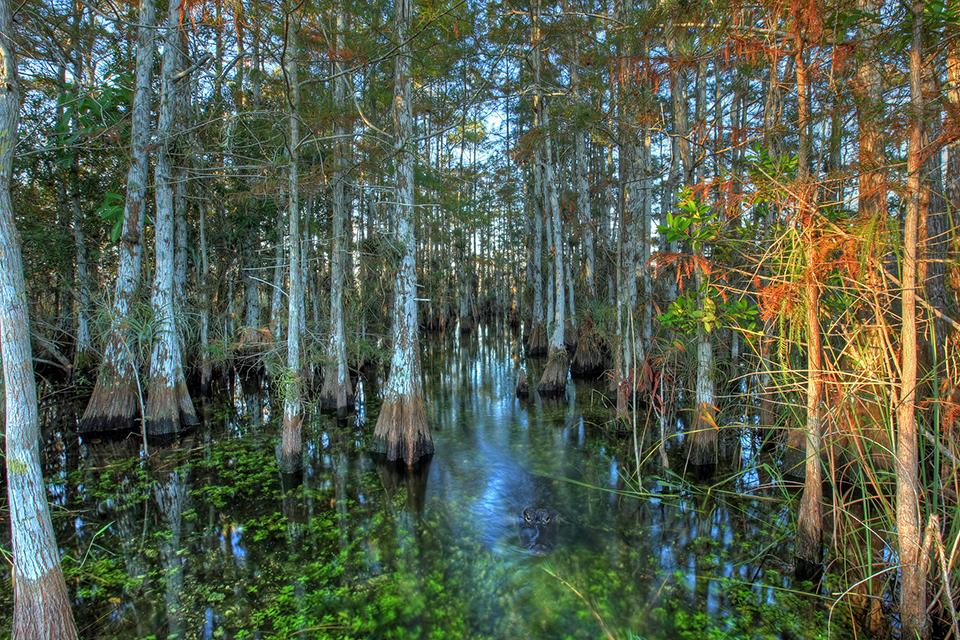
Peering into a cypress dome, Everglades National Park / National Park Service
Common throughout the southeastern United States, the cypress tree (Taxodium spp.) is a deciduous conifer that can survive in standing water. In the Florida Everglades these trees are often found growing in one of three distinct formations. One of those formations is called the “cypress dome.” Where the limestone substrate has given way to circular solution holes, it is common to find a cluster of cypress trees growing in the shape of a dome, with larger trees in the middle and smaller trees all around.

A jellied mass of salamander eggs, Lewis and Clark National Historic Trail / National Park Service
As you explore the landscape along the Lewis and Clark National Historic Trail, you might come across “a firm, globular ball of jelly” in a pond that looks like the image above. “Meet the Northwestern Salamander (Ambystoma gracile). This semi-aquatic salamander can be up to 25cm from snout to end of the tail and can be found in and around ponds and wetlands and in the surrounding forest. Females lay a single egg mass that contains 50 to 100 eggs! The small eggs are encapsulated within several layers of jelly, and hatch in four to six weeks, depending on water temperature.”
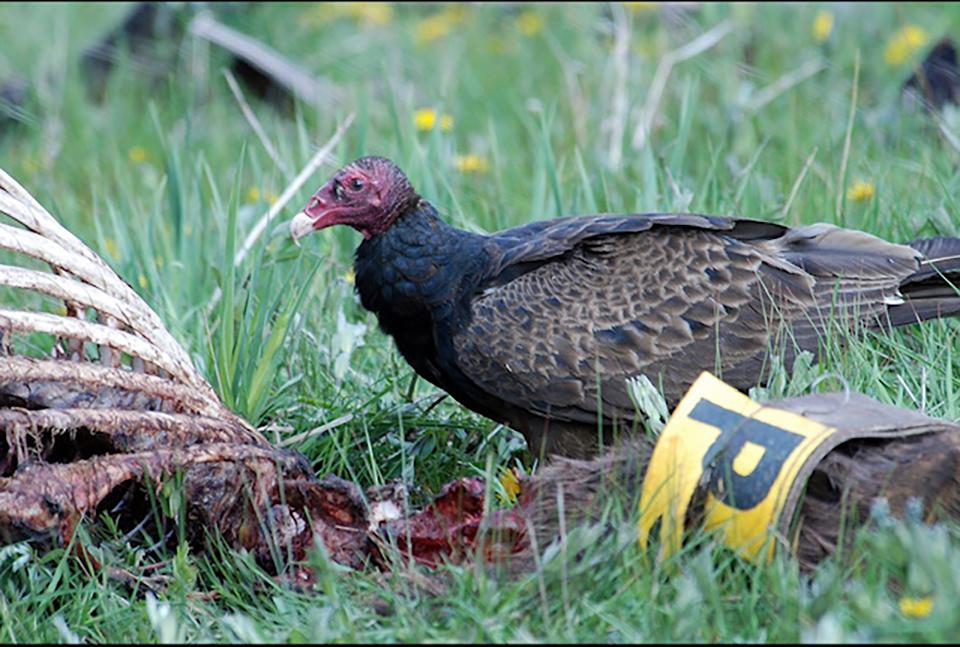
Turkey vulture, Bandelier National Monument / National Park Service
With a face only a mother could love, “turkey vultures (Cathartes aura) play a vital role in ecosystems like Valles Caldera [National Preserve] / Bandelier [National Monument]: cleanup! Rather than hunting their prey, scavengers eat animals that have died of natural causes or been killed by another animal. If left unattended, dead animals can transmit diseases to other animals in the ecosystem, including humans … Turkey vultures are particularly well equipped for the job [of scavenger]. Their keen eyesight and sense of smell let them find dead animals from miles away, and their strong stomach acid and gut bacteria allow them to eat rotting meat without getting sick. In addition, as well as helping vultures regulate their temperatures, their featherless heads help them stay clean while feeding.”
Quiz Answers
1a
“The Virgin River carries out one million tons of sediment every year, carving the canyon as you read these words. Water and time are the main tools of creation, using flash floods and rockfalls as natural agents of change … The Virgin River is a powerful force, so make sure to always check the weather forecast and the flash flood rating before hiking in or along the water.”
2c
When an animal [or insect] uses a visual cue to warn predators that it is toxic or dangerous, that is called aposematism. To learn more about Everglades’ insects, click here.
3b False
According to asknature.org: “… One unusual defense mechanism involves the flooding of their ocular sinuses, tissues found below their eye, with blood. When a horned lizard feels threatened by a predator, its final defense response is to shoot blood from these flooded sinuses and out its eye sockets. As a result, the predator is often frightened and flees. The lizard also uses this mechanism to remove foreign particles from the surface of its eyes.”
4b False
The name for a baby porcupine is a porcupette. “They have soft quills when they are born, but they grow stonger day by day. Adults have about 30,000 quills that help them defend against predators and stay warm.”
5b False
Porcupines cannot throw their quills. “On occasion, loose quills will fall out before [the porcupine] strikes, creating the illusion that they’re being shot out. Get the point? Oh, and they are slow movers, “attaining a maximum speed of only two miles per hour … and porcupines have a strong odor to warn away predators, which they can increase when agitated. The smell has been described as similar to strong human body odor, goats, or some cheeses.”
6a
“Ice balls (aka spheres or boulders) are formed when waves break off pieces of ice sheets. The waves then roll these ice chunks over and over again, smoothing and shaping them into spheres. They can accrue more layers of ice, growing quite large.
7b False
This is a tricky question, and the key word here is “all.” According to air-plants.com: “The Tillandsia [air plant] genus, of which there are over 700 species, fall into the Bromeliad (Bromeliaceae) family. So, all Tillandsias are considered Bromeliads. But not all Bromeliads are Tillandsia though, as there are 3 main sub families in the Bromeliaceae family, Tillandsioideae ( Tillandsias), Bromelioideae, and Pitcairnioideae.” If you listened to the Traveler’s Podcast Episode 166, you will have heard an in-the-field discussion of air plants and bromeliads.
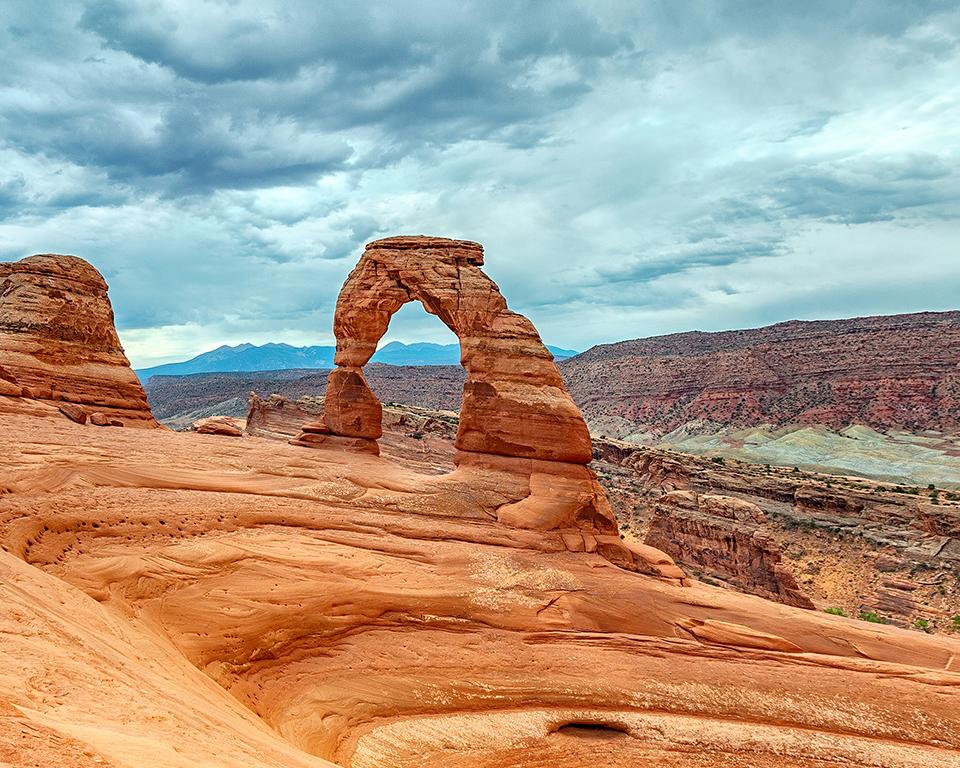
Delicate Arch and surrounding landscape, Arches National Park / Rebecca Latson
8b False
The key here is the term “free-standing.” “The light opening beneath [Delicate Arch] is 46 feet high and 32 feet wide, making it the largest free-standing arch in the park. It has had more than a few names in its history, from the colorful ("Cowboy's Chaps", "Old Maid's Bloomers") to the prosaic ("Salt Wash Arch"). The term "Delicate" first appeared in a January 1934 article about the Arches National Monument Scientific Expedition, which described it as ‘the most delicately chiseled arch in the entire area.’”
9d
Between 18,000 to 13,000 years ago, when the ice dam holding back 2000-feet-deep Glacial Lake Missoula broke, 500 million cubic miles of floodwaters from the lake flowed over the land, eroding the landscape to create deep ravines known as coulees and stripping away the fertile soil. The Channeled Scabland remained as testament to the power of all that flowing water. To learn more about the floodwaters and Channeled Scabland, click here.
10a
Five endemic species are found in Montezuma Well: Montezuma Well springsnail, water scorpion, Hyalella amphipod, Motobdella Montezuma leech, and diatom algae. To learn more about Montezuma Well, click here.
References:
In addition to information from the websites and Instagram accounts of the various National Parks, the following references were used.:
Bruce Bjornstad & Eugene Kiver, On The Trail Of The Ice Age Floods, The Northern Reaches, 2017 second printing, Keokee Books



Add comment